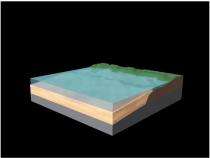Geochemical processes go high-tech in 3-D, interactive project

(PhysOrg.com) -- They occur constantly, are largely invisible but affect everything from energy supplies and soil erosion to water pollution.
Now the Center for Environmental Kinetics Analysis (CEKA) has made visible many of those fundamental geochemical processes through a 3-D, interactive educational “movie.” The project, called “Slices of Time,” allows viewers to “see” examples of geochemical processes that occur at 14 different time scales from years and hours to seconds and even smaller.
“We wanted something that would be immersive, interactive, educational and fun,” said Brantley, who also directs the Earth and Environmental Systems Institute (EESI) and is a distinguished professor of geosciences. “And we wanted something that could convey the immense complexity of time scales that operate at the Earth’s surface.”
It was up to Chuck Anderson, visualization and outreach specialist with the center, to make it happen. That took about three years and involved technical help from the University’s GEaRS (Graduate Education and Research Services) Visualization Group as well as from more than a dozen CEKA faculty and graduate students.
Students played a big role. Tim Fischer and Andy Wall, graduate students in geosciences, co-wrote the script with Wall also serving as narrator. And a CEKA-supported undergraduate got in the act: Andy Greenwood, who was on campus in summer 2005 as part of the Research Experience for Undergraduates (REU) program, wrote the music.
Deciding to use time steps was perhaps the easiest part, Anderson said.
“Then we had to figure out how to do that and learn the software that would allow us to do what we wanted,” Anderson said. “The technical challenges were significant — in one segment, for instance, we had to find a way to show in minutes the chemical processes that result in the formation of river valleys that take millions of years.”
At the other end of the time scale, the group had to slow down electron movement measured in attoseconds — or quintillionths of a single second. For comparison, in the time it took to read this sentence, billions and billions of attoseconds have passed.
One of the advantages of creating this interactive computer application is flexibility. Because the audio is separate from the video, making a Spanish or other language version is simplified, Anderson said.
Likewise, any of the 14 time slices can be updated to reflect new data or expanded to fit the needs of individual instructors or museums. Even new time periods can be added fairly easily. One possibility: Including milliseconds, for instance.
“We designed ‘Slices of Time’ to be useful for teachers — to supplement lesson plans or enhance curriculum,” said Anderson, who envisions another project, “Time Scales of Climate Change.”
NSF’s Covert was so impressed with the project and its potential for communicating complex science a special showing at the agency’s headquarters in Washington, D.C., has been scheduled for Tuesday, Dec. 2.
“This shows one of the advantages of funding a center,” Covert said. “Centers can tackle the large projects that an individual can’t do.”
Provided by Penn State





















